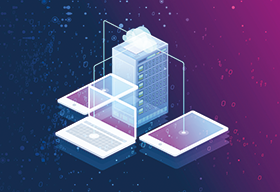

Not having access to critical data for even a few hours can cause irreparable damage in the form of lost business, fines and reputational damage. According to Gartner, the average cost of IT downtime is US$5600 per minute.
Whether it’s ransomware, riots or the malicious behaviour of a disgruntled employee, for organisations to recover effectively from a disaster they first need to be sure all their critical data is backed up. However, given the complex nature of today’s multi and hybrid cloud IT environments, there’s every chance they won’t know they have everything valuable protected until it’s too late.
Keeping track of data on multiple different platforms and having visibility of it all is already a major headache for IT departments, never mind ensuring business-critical data is backed up. Therefore it’s important to deploy a backup and recovery solution with the widest coverage and the ability to identify gaps in protection.
Downtime is costly enough when it results from accidental failures in technology, but when it’s down to hackers or malicious behaviour, the monetary consequences can soar to an alarming, often business-ruining rate. The expansion of data across on-premises infrastructure, cloud infrastructure (public, private and multi-cloud), SaaS applications and endpoint devices has only increased the attack surface.
The potential vulnerabilities, arising from configuration weaknesses, are providing cyber-criminals with greater opportunities to wreak havoc.
Adopting a layered defence-in-depth approach with the latest anti-malware for backups enhances the ability to spot zero-day threats, which can make all the difference in avoiding encryption and downtime, as well as exfiltration and extortion. Deploying multiple methods to protect your environment also conforms with guidance recommended by leading government communications and cybersecurity agencies.
There’s no way of keeping on-premises, cloud or SaaS infrastructure or applications 100% safe from a ransomware attack, so it’s vital to protect backups. Whatever malware detection is deployed to scan live data, it makes no sense to use the same for backups. If the software simply checks for the same signatures, malicious files will be missed in both live and backup data.
Deploying a solution that harnesses artificial intelligence (AI) to police backups and detect threats not only verifies the health of backups, it provides yet another chance to spot ransomware before it encrypts everything.
Backup strategy to enable successful recoveries
Air gap: Guarantee that the primary and backup storage systems are physically separated. Bad actors won’t be able to access the backup data copies because of this physical break.
3-2-1-1 strategy: The most recent best practice provides three copies of data, two separate media for backup storage, one offsite backup storage location (online) plus an offsite backup storage location (offline/air gapped).
Backup data malware detection and removal: Ransomware frequently stays idle on a network for long periods of time before encrypting systems, ensuring that it is present in all backup versions, making malware-free recovery impossible. To effectively protect against ransomware, the capacity to detect and remove ransomware from backup data, as well as having an isolated location in which to restore data, has become critical.
Instant/rapid recovery flexibility: Downtime can be just as detrimental as data loss. To be effective, a backup strategy must allow users to get back to work quickly by allowing temporary access to data if needed and prioritising crucial data recovery if it is required.
Backups are the best last line of defence for ensuring a quick recovery, but critical to this is the ability to test those systems on a regular basis to ensure they are working correctly. Your solution should deliver access to files and information immediately in the event of a disaster and the technology exists that allows you to stream on demand whatever is required to keep employees working, while the rest of your data is restored in the background.
Establishing, refining and recording DR steps will improve your operational response and minimise disruption, should an incident occur. An efficient and cost-effective way to do this is to have your backed-up systems and data presented for temporary access as a virtual drive and for permanent recovery to a destination of your choice.
With a cloud-based backup and recovery platform you can also avoid the expense of duplicate data centres and failover infrastructure that sit idle most of the time. A good solution should allow you to start protecting multiple sites on day one with zero upfront costs and scale infinitely with total cost predictability, while regular testing of your disaster recovery processes should give you peace of mind and the confidence that you can respond rapidly in the event of a crisis.
Redstor, the MSP’s backup and recovery platform, offers the simplest, smartest way to serve customers and drive profitability. The solution unifies backup and recovery to protect modern, legacy and SaaS infrastructure with a single app. Streaming provides instant data access and fast recovery, with AI finding and automatically removing malware for safe restores.
Learn more at www.redstor.com

© Technews Publishing (Pty) Ltd. | All Rights Reserved.